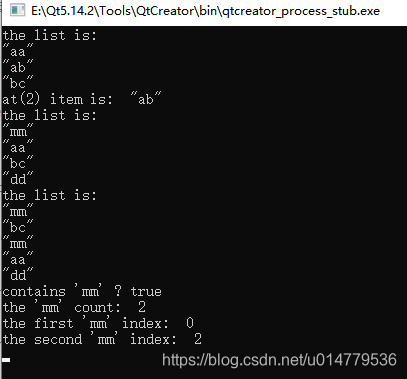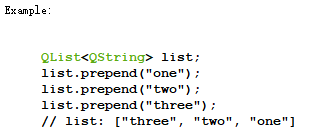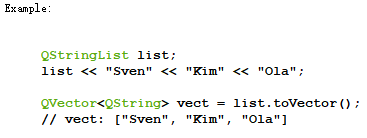文章目录
1. 简介
QList<T>是目前最常用的容器类 。它存储了给定类型的值的一个列表,而这些值可以通过索引访问。在内部,QList使用数组来实现,一确保进行快速的基于索引的访问。可以使用QList::append()和QList::prepend()在列表的两端添加项目,也可以使用QList::insert()在列表的中间插入项目。常用的QStringList继承自QList<QString>。
2. 使用示例
#include<QCoreApplication>#include<QList>#include<QDebug>intmain(int argc,char*argv[]){
QCoreApplication a(argc, argv);// 定义QList变量
QList<QString> list;// 插入项目
list <<"aa"<<"bb"<<"cc";// 查询和重新定义元素if(list[1]=="bb"){
list[1]="ab";}// 替换第3个元素
list.replace(2,"bc");// 将“cc”换为“bc”// 打印元素qDebug()<<"the list is: ";for(int i=0; i<list.size();++i){qDebug()<< list.at(i);// 现在列表为aa ab bc}// 在列表尾部添加元素
list.append("dd");// 在列表头部添加元素
list.prepend("mm");// 从列表中删除第3个项目,并获取它
QString str = list.takeAt(2);// 打印刚才删除的元素qDebug()<<"at(2) item is: "<< str;// 打印列表qDebug()<<"the list is: ";for(int i=0; i<list.size();++i){qDebug()<< list.at(i);// 现在列表为mm aa bc dd}// 在位置2插入项目
list.insert(2,"mm");// 交换项目1和项目3
list.swap(1,3);// 打印列表qDebug()<<"the list is: ";for(int i=0; i<list.size();++i){qDebug()<< list.at(i);// 现在列表为mm bc mm aa dd}// 列表中是否包含“mm”qDebug()<<"contains 'mm' ?"<< list.contains("mm");// 包含“mm”的个数qDebug()<<"the 'mm' count: "<< list.count("mm");// 第一个“mm”的位置,默认从位置0开始往前查找,返回第一个匹配的项目的位置qDebug()<<"the first 'mm' index: "<< list.indexOf("mm");// 第二个“mm”的位置,我们指定从位置1开始往前查找qDebug()<<"the second 'mm' index: "<< list.indexOf("mm",2);return a.exec();}
执行结果:
程序说明:
- 添加元素
QList<QString> list;
list <<"aa"<<"bb"<<"cc";// 插入项目
- 赋值操作
list[0]="aa";
- 替换操作
list.replace(2,"bc");
- 获取大小
int length = list.size();
- 获取元素值
list.at(i)
- 在列表尾部添加
list.append("dd");
- 在列表头部添加
list.prepend("mm");
- 删除元素并获取
QString str = list.takeAt(2);
- 在指定位置插入
list.insert(2,"mm");
- 交换元素
list.swap(1,3);
- 列表是否包含某值
list.contains("mm");
- 列表包含某值个数
list.count("mm");
- 元素位置,从0开始查找
list.indexOf("mm");
- 元素位置,从指定位置查找
list.indexOf("mm",2);
3. 官方手册
https://doc.qt.io/qt-5/qlist.html
4. Member Function Documentation
QList::QList(InputIterator first, InputIterator last)
构造一个包含迭代器范围[first, last]中的内容的QList。
InputIterator的值类型必须转换为T。
这个函数是在Qt 5.14中引入的。
QList::QList(std::initializer_list<T> args)
从args指定的std::initializer_list构造一个列表。
这个构造函数只有在编译器支持c++ 11初始化器列表时才启用。
这个函数是在Qt 4.8中引入的。
QList::QList(QList<T>&&other)
Move构造一个QList实例,使其指向其他对象指向的同一对象。
此功能在Qt 5.2中引入。
QList::QList(const QList<T>&other)
构造其他的副本。
由于QList是隐式共享的,因此此操作花费的时间是恒定的。 这使得从函数快速返回QList成为可能。 如果共享实例被修改,它将被复制(写时复制),这需要花费线性时间。
另请参阅operator =()。
QList :: QList()
构造一个空列表。
QList <T>&QList ::operator=(QList <T>&& other)
将其他移动到此QList实例。
此功能在Qt 5.2中引入。
QList <T>&QList ::operator=(const QList <T>&other)
将其他分配给该列表,并返回对该列表的引用。
QList::~QList()
销毁该列表。 对列表中的值的引用以及该列表的所有迭代器均无效。
void QList::append(const T &value)
在列表的末尾插入值。
示例:
这与
list.insert(size(), value)
相同.
如果未共享此列表,则此操作通常非常快(摊销的固定时间),因为QList在其内部缓冲区的两侧预分配了额外的空间,以允许在列表的两端快速增长。
另参见
operator<<()
,
prepend()
, 和
insert()
.
void QList::append(const QList<T>&value)
这是一个重载功能。
将值列表的项目追加到此列表。
此功能在Qt 4.5中引入。
另参见
operator<<()
和
operator+=()
.
const T &QList::at(int i)const
返回列表中索引位置i处的项目。 我必须是列表中的有效索引位置(即 0<=i<size())。
此功能非常快(恒定时间)。
另参见
value()
和
operator[]()
.
T &QList::back()
提供此功能是为了实现STL兼容性。 它等效于last()。 该列表不能为空。 如果列表可以为空,请在调用此函数之前调用isEmpty()。
const T &QList::back()const
这是一个重载功能。
QList::iterator QList::begin()
返回一个STL样式的迭代器,该迭代器指向列表中的第一项。
另参见
constBegin()
和
end()
.
QList::const_iterator QList::begin()const
这是一个重载功能
QList::const_iterator QList::cbegin()const
返回指向列表中第一项的const STL样式迭代器。
此功能在Qt 5.0中引入。
另参见
begin()
和
cend()
.
QList::const_iterator QList::cend()const
返回一个const STL样式的迭代器,该迭代器指向列表中最后一个项目之后的虚拟项目。
此功能在Qt 5.0中引入。
另参见
cbegin()
和
end()
.
void QList::clear()
从列表中删除所有项目。
另参见
removeAll()
.
QList::const_iterator QList::constBegin()const
返回指向列表中第一项的const STL样式迭代器。
另参见
begin()
和
constEnd()
.
QList::const_iterator QList::constEnd()const
返回一个const STL样式迭代器,该迭代器指向列表中最后一个项之后的假想项。
另参见
constBegin()
和
end()
.
const T &QList::constFirst()const
返回对列表中第一项的常量引用。列表不能为空。如果列表可以为空,请在调用此函数之前调用isEmpty()。
qt5.6中引入了这个函数。
另参见
constLast()
,
isEmpty()
, 和
first()
.
const T &QList::constLast()const
返回对列表中最后一项的引用。列表不能为空。如果列表可以为空,请在调用此函数之前调用isEmpty()。
qt5.6中引入了这个函数。
另参见
constFirst()
,
isEmpty()
, 和
last()
.
bool QList::contains(const T &value)const
如果列表包含值的出现,则返回true;否则返回false。
此函数要求值类型具有运算符==()的实现。
另参见
indexOf()
和
count()
.
int QList::count(const T &value)const
返回值在列表中出现的次数。
此函数要求值类型具有运算符==()的实现。
另参见
contains()
和
indexOf()
.
int QList::count()const
返回列表中的项数。这实际上与size()相同。
QList::const_reverse_iterator QList::crbegin()const
以相反的顺序返回指向列表中第一项的const STL样式反向迭代器。
qt5.6中引入了这个函数。
另参见
begin()
,
rbegin()
, 和
rend()
.
QList::const_reverse_iterator QList::crend()const
以相反的顺序返回一个const STL样式的反向迭代器,该迭代器指向列表中最后一项之后的一个。
此功能在Qt 5.6中引入。
另参见
end()
,
rend()
, 和
rbegin()
.
bool QList::empty()const
提供此功能是为了实现STL兼容性。 它等效于isEmpty(),如果列表为空,则返回true。
QList::iterator QList::end()
返回一个STL样式的迭代器,该迭代器指向列表中最后一个项目之后的虚拟项目。
另请参见
begin()
和
constEnd()
。
QList::const_iterator QList::end()const
这是一个重载函数。
bool QList::endsWith(const T &value)const
如果此列表不为空并且其最后一项等于value,则返回true;否则,返回true。 否则返回false。
此功能在Qt 4.5中引入。
另请参见
isEmpty()
和
contains()
。
QList::iterator QList::erase(QList::iterator pos)
从列表中删除与迭代器pos关联的项目,并将迭代器返回到列表中的下一个项目(可能是end())。
另请参见
insert()
和
removeAt()
。
QList::iterator QList::erase(QList::iterator begin, QList::iterator end)
这是一个重载函数。
从开始到(但不包括)结束删除所有项目。 将迭代器返回到调用之前结束引用的同一项目。
T &QList::first()
返回对列表中第一项的引用。 该列表不能为空。 如果列表可以为空,请在调用此函数之前调用isEmpty()。
另请参见
constFirst()
,
last()
和
isEmpty()
。
const T &QList::first()const
这是一个重载函数。
[static] QList<T> QList::fromSet(const QSet<T>&set)
返回带有包含在set中的数据的QList对象。 QList中元素的顺序未定义。
示例:
QSet<int> set;
set <<20<<30<<40<<...<<70;
QList<int> list = QList<int>::fromSet(set);
std::sort(list.begin(), list.end());
注意:从Qt 5.14开始,范围构造函数可用于Qt的通用容器类,并且应代替此方法使用。
另请参见
fromVector()
,
toSet()
和
QSet :: toList()
。
[static] QList<T> QList::fromStdList(const std::list<T>&list)
返回一个QList对象,列表中包含数据。 QList中元素的顺序与list中的顺序相同。
示例:
std::list<double> stdlist;
list.push_back(1.2);
list.push_back(0.5);
list.push_back(3.14);
QList<double> list = QList<double>::fromStdList(stdlist);
注意:从Qt 5.14开始,范围构造函数可用于Qt的通用容器类,并且应代替此方法使用。
另请参见
toStdList()
和
QVector :: fromStdVector()
。
[static] QList<T> QList::fromVector(const QVector<T>&vector)
返回带有向量中包含的数据的QList对象。
示例:
QVector<double> vect;
vect <<20.0<<30.0<<40.0<<50.0;
QList<double> list = QVector<T>::fromVector(vect);// list: [20.0, 30.0, 40.0, 50.0]
注意:从Qt 5.14开始,范围构造函数可用于Qt的通用容器类,并且应代替此方法使用。
另请参见
fromSet()
,
toVector()
和
QVector :: toList()
。
T &QList::front()
提供此功能是为了实现STL兼容性。 它等效于first()。 该列表不能为空。 如果列表可以为空,请在调用此函数之前调用isEmpty()。
const T &QList::front()const
这是一个重载函数
int QList::indexOf(const T &value,int from =...)const
返回列表中第一个出现的值的索引位置,从索引位置from开始向前搜索。 如果没有匹配项,则返回-1。
示例:
QList<QString> list;
list <<"A"<<"B"<<"C"<<"B"<<"A";
list.indexOf("B");// returns 1
list.indexOf("B",1);// returns 1
list.indexOf("B",2);// returns 3
list.indexOf("X");// returns -1
此函数要求值类型具有operator ==()的实现。
请注意,QList使用基于0的索引,就像C ++数组一样。 除上述值外,不支持负索引。
另请参见
lastIndexOf()
和
contains()
。
void QList::insert(int i,const T &value)
在列表中索引位置i处插入值。 如果i <= 0,则该值位于列表的前面。 如果i> = size(),则将值附加到列表中。
Example:
QList<QString> list;
list <<"alpha"<<"beta"<<"delta";
list.insert(2,"gamma");// list: ["alpha", "beta", "gamma", "delta"]
另参见
append()
,
prepend()
,
replace()
, 和
removeAt()
.
QList::iterator QList::insert(QList::iterator before,const T &value)
这是一个重载函数。
在迭代器之前指向的项目前面插入值。 返回指向插入项的迭代器。 注意,调用后传递给该函数的迭代器将无效。 应该使用返回的迭代器代替。
bool QList::isEmpty()const
如果列表不包含任何项目,则返回true;否则,返回true。 否则返回false。
See also
size()
.
T &QList::last()
返回对列表中最后一项的引用。 该列表不能为空。 如果列表可以为空,请在调用此函数之前调用isEmpty()。
See also
constLast()
,
first()
, and
isEmpty()
.
const T &QList::last()const
这是一个重载函数。
int QList::lastIndexOf(const T &value,int from =...)const
返回列表中最后一次出现的值的索引位置,从索引位置from开始向后搜索。 如果from为-1(默认值),则搜索从最后一项开始。 如果没有匹配项,则返回-1。
Example:
QList<QString> list;
list <<"A"<<"B"<<"C"<<"B"<<"A";
list.lastIndexOf("B");// returns 3
list.lastIndexOf("B",3);// returns 3
list.lastIndexOf("B",2);// returns 1
list.lastIndexOf("X");// returns -1
此函数要求值类型具有operator ==()的实现。
请注意,QList使用基于0的索引,就像C ++数组一样。 除上述值外,不支持负索引。
See also
indexOf()
.
int QList::length()const
此函数与count()相同。
此功能在Qt 4.5中引入。
See also
count()
.
QList<T> QList::mid(int pos,int length =-1)const
void QList::move(int from,int to)
将索引位置的项目从移到索引位置。
Example:
这与insert(to,takeAt(from))相同。此函数假定from和to都至少为0但小于size()。 为避免失败,请测试from和to两者均至少为0且小于size()。
See also
swap()
,
insert()
, and
takeAt()
.
void QList::pop_back()
提供此功能是为了实现STL兼容性。 它等效于removeLast()。 该列表不能为空。 如果列表可以为空,请在调用此函数之前调用isEmpty()。
void QList::pop_front()
提供此功能是为了实现STL兼容性。 它等效于removeFirst()。 该列表不能为空。 如果列表可以为空,请在调用此函数之前调用isEmpty()。
void QList::prepend(const T &value)
在列表的开头插入值。
这与list.insert(0,value)相同。
如果未共享此列表,则此操作通常非常快(摊销的固定时间),因为QList在其内部缓冲区的两侧预分配了额外的空间,以允许在列表的两端快速增长。
See also
append()
and
insert()
.
void QList::push_back(const T &value)
提供此功能是为了实现STL兼容性。 它等效于append(value)。
void QList::push_front(const T &value)
提供此功能是为了实现STL兼容性。 它等效于prepend(value)。
QList::reverse_iterator QList::rbegin()
以相反的顺序返回指向列表中第一项的STL样式反向迭代器。
此功能在Qt 5.6中引入。
See also
begin()
,
crbegin()
, and
rend()
.
QList::const_reverse_iterator QList::rbegin()const
这是一个重载函数。
此功能在Qt 5.6中引入。
int QList::removeAll(const T &value)
删除列表中所有出现的value并返回删除的条目数。
此函数要求值类型具有operator ==()的实现。
See also
removeOne()
,
removeAt()
,
takeAt()
, and
replace()
.
void QList::removeAt(int i)
删除索引位置i处的项目。 我必须是列表中的有效索引位置(即0 <= i <size())。
See also
takeAt()
,
removeFirst()
,
removeLast()
, and
removeOne()
.
void QList::removeFirst()
删除列表中的第一项。 调用此函数等效于调用removeAt(0)。 该列表不能为空。 如果列表可以为空,请在调用此函数之前调用isEmpty()。
See also
removeAt()
and
takeFirst()
.
void QList::removeLast()
删除列表中的最后一项。 调用此函数等效于调用removeAt(size()-1)。 该列表不能为空。 如果列表可以为空,请在调用此函数之前调用isEmpty()。
See also
removeAt()
and
takeLast()
.
bool QList::removeOne(const T &value)
删除列表中第一个出现的值,并在成功时返回true; 否则返回false。
此函数要求值类型具有operator ==()的实现。
此功能在Qt 4.4中引入。
See also
removeAll()
,
removeAt()
,
takeAt()
, and
replace()
.
QList::reverse_iterator QList::rend()
以相反的顺序返回一个STL样式的反向迭代器,该迭代器指向列表中最后一项之后的一个。
此功能在Qt 5.6中引入。
See also
end()
,
crend()
, and
rbegin()
.
QList::const_reverse_iterator QList::rend()const
这是一个重载功能。
此功能在Qt 5.6中引入。
void QList::replace(int i,const T &value)
用值替换索引位置i处的项目。 我必须是列表中的有效索引位置(即0 <= i <size())。
See also
operator[]()
and
removeAt()
.
void QList::reserve(int alloc)
为分配元素保留空间。
如果alloc小于列表的当前大小,则不会发生任何事情。
如果您可以预测要添加多少个元素,请使用此功能避免重复分配QList内部数据。 请注意,保留仅适用于内部指针数组。
此功能在Qt 4.7中引入。
int QList::size()const
返回列表中的项目数。
See also
isEmpty()
and
count()
.
bool QList::startsWith(const T &value)const
如果此列表不为空并且其第一项等于value,则返回true;否则,返回true。 否则返回false。
此功能在Qt 4.5中引入。
See also
isEmpty()
and
contains()
.
void QList::swap(QList<T>&other)
交换其他与此列表。 此操作非常快,并且永远不会失败。
此功能在Qt 4.8中引入。
void QList::swapItemsAt(int i,int j)
将索引位置i处的项目与索引位置j处的项目进行交换。 此函数假定i和j都至少为0但小于size()。 为避免失败,请测试i和j至少为0并小于size()。
此功能在Qt 5.13中引入。
See also
move()
.
T QList::takeAt(int i)
删除索引位置i处的项目并返回它。 我必须是列表中的有效索引位置(即0 <= i <size())。
如果不使用返回值,则removeAt()会更有效。
See also
removeAt()
,
takeFirst()
, and
takeLast()
.
T QList::takeFirst()
删除列表中的第一项并返回它。 这与takeAt(0)相同。 此函数假定列表不为空。 为避免失败,请在调用此函数之前调用isEmpty()。
如果未共享此列表,则此操作将花费固定时间。
如果不使用返回值,则removeFirst()会更有效。
See also
takeLast()
,
takeAt()
, and
removeFirst()
.
T QList::takeLast()
删除列表中的最后一项并返回。 这与takeAt(size()-1)相同。 此函数假定列表不为空。 为避免失败,请在调用此函数之前调用isEmpty()。
如果未共享此列表,则此操作将花费固定时间。
如果不使用返回值,则removeLast()会更有效。
See also
takeFirst()
,
takeAt()
, and
removeLast()
.
QSet<T> QList::toSet()const
返回带有此QList中包含的数据的QSet对象。 由于QSet不允许重复,因此生成的QSet可能小于原始列表。
注意:从Qt 5.14开始,范围构造函数可用于Qt的通用容器类,并且应代替此方法使用。
See also
toVector()
,
fromSet()
, and
QSet::fromList()
.
std::list<T> QList::toStdList()const
返回带有此QList中包含的数据的std :: list对象。 例:
注意:从Qt 5.14开始,范围构造函数可用于Qt的通用容器类,并且应代替此方法使用。
See also
fromStdList()
and
QVector::toStdVector()
.
QVector<T> QList::toVector()const
返回带有此QList中包含的数据的QVector对象。
注意:从Qt 5.14开始,范围构造函数可用于Qt的通用容器类,并且应代替此方法使用。
See also
toSet()
,
fromVector()
, and
QVector::fromList()
.
T QList::value(int i)const
返回列表中索引位置i处的值。
如果索引i超出范围,则该函数将返回默认构造的值。 如果确定索引将在范围内,则可以使用at()来代替,这会稍微快一些。
See also
at()
and
operator[]()
.
T QList::value(int i,const T &defaultValue)const
这是一个过载功能。
如果索引i超出范围,则该函数返回defaultValue。
bool QList::operator!=(const QList<T>&other)const
如果other不等于此列表,则返回true;否则,返回false。 否则返回false。
如果两个列表包含相同顺序的相同值,则认为它们相等。
此函数要求值类型具有operator ==()的实现。
See also
operator==()
.
QList<T> QList::operator+(const QList<T>&other)const
返回一个列表,其中包含此列表中的所有项目,然后是另一个列表中的所有项目。
See also
operator+=()
.
QList<T>&QList::operator+=(const QList<T>&other)
将另一个列表的项目追加到此列表,并返回对该列表的引用。
See also
operator+()
and
append()
.
QList<T>&QList::operator+=(const T &value)
这是一个过载功能。
将值追加到列表。
See also
append()
and
operator<<()
.
QList<T>&QList::operator<<(const QList<T>&other)
将另一个列表的项目追加到此列表,并返回对该列表的引用。
See also
operator+=()
and
append()
.
QList<T>&QList::operator<<(const T &value)
这是一个过载功能。
将值追加到列表。
bool QList::operator==(const QList<T>&other)const
如果other等于此列表,则返回true;否则,返回true。 否则返回false。
如果两个列表包含相同顺序的相同值,则认为它们相等。
此函数要求值类型具有operator ==()的实现。
See also
operator!=()
.
T &QList::operator[](int i)
返回索引位置i处的项目作为可修改的参考。 我必须是列表中的有效索引位置(即0 <= i <size())。
如果在当前正在共享的列表上调用此函数,它将触发所有元素的副本。 否则,此功能将以恒定时间运行。 如果不想修改列表,则应使用QList :: at()。
See also
at()
and
value()
.
const T &QList::operator[](int i)const
这是一个重载功能。
Same as
at().
此函数以恒定时间运行。
版权归原作者 超级大洋葱806 所有, 如有侵权,请联系我们删除。